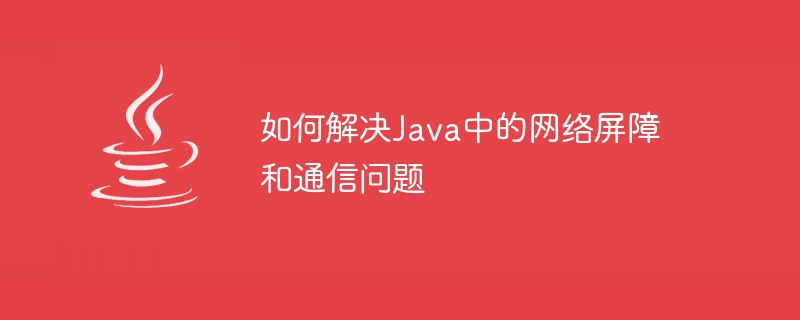如何解決Java中的網路屏障和通訊問題
- WBOY原創
- 2023-10-09 15:36:111147瀏覽

如何解決Java中的網路屏障和通訊問題
在Java開發中,網路屏障和通訊問題是常見的挑戰。在網路通訊過程中,可能會遇到連線問題、資料傳輸延遲、通訊異常等。為了解決這些問題,我們可以採用一些方法和技術來優化網路通訊的效能和穩定性。本文將介紹一些常見的解決方案,並提供相應的程式碼範例。
- 使用多執行緒處理網路通訊
在Java中,我們可以使用多執行緒來處理網路通信,以提高通訊的效率和並發性。透過將每個網路請求或連線作為一個獨立的線程來處理,可以避免阻塞主線程,提高系統的並發處理能力。
以下是一個簡單的範例,示範如何使用多執行緒處理網路通訊:
import java.io.*;
import java.net.*;
public class NetworkThread extends Thread {
private Socket socket;
public NetworkThread(Socket socket) {
this.socket = socket;
}
public void run() {
try {
// 处理网络通信逻辑
// ...
} catch (IOException e) {
// 处理异常
e.printStackTrace();
} finally {
// 关闭socket连接
try {
socket.close();
} catch (IOException e) {
e.printStackTrace();
}
}
}
}
public class Server {
public static void main(String[] args) throws IOException {
ServerSocket serverSocket = new ServerSocket(8080);
while (true) {
Socket socket = serverSocket.accept();
NetworkThread networkThread = new NetworkThread(socket);
networkThread.start();
}
}
}- 使用非阻塞I/O
Java提供了非阻塞I/O(NIO)的方式來處理網路通信,可以提高系統的效能和資源利用率。 NIO基於事件驅動模型,使得網路IO操作可以非同步進行,當有可讀或可寫入的資料時,會觸發對應的事件並進行對應的處理。
以下是一個簡單的範例,示範如何使用NIO處理網路通訊:
import java.io.*;
import java.net.*;
import java.nio.*;
import java.nio.channels.*;
public class Server {
public static void main(String[] args) throws IOException {
ServerSocketChannel serverSocketChannel = ServerSocketChannel.open();
serverSocketChannel.bind(new InetSocketAddress(8080));
serverSocketChannel.configureBlocking(false);
Selector selector = Selector.open();
serverSocketChannel.register(selector, SelectionKey.OP_ACCEPT);
while (true) {
selector.select();
for (SelectionKey selectionKey : selector.selectedKeys()) {
if (selectionKey.isAcceptable()) {
SocketChannel socketChannel = serverSocketChannel.accept();
socketChannel.configureBlocking(false);
socketChannel.register(selector, SelectionKey.OP_READ);
} else if (selectionKey.isReadable()) {
SocketChannel socketChannel = (SocketChannel) selectionKey.channel();
ByteBuffer buffer = ByteBuffer.allocate(1024);
int bytesRead = socketChannel.read(buffer);
if (bytesRead > 0) {
// 处理读取的数据
buffer.flip();
byte[] bytes = new byte[buffer.remaining()];
buffer.get(bytes);
System.out.println("Received: " + new String(bytes));
buffer.clear();
} else if (bytesRead == -1) {
socketChannel.close();
}
}
}
selector.selectedKeys().clear();
}
}
}- 使用訊息佇列進行非同步通訊
當網路通訊的速度和資料量較大時,為了提高系統的吞吐量和回應時間,可以使用訊息佇列來進行非同步通訊。透過將訊息傳送到佇列中,可以在不同的執行緒中進行處理,以避免網路通訊的阻塞和延遲。
以下是一個簡單的範例,示範如何使用訊息佇列進行非同步通訊:
import java.util.concurrent.*;
public class Producer implements Runnable {
private BlockingQueue<String> queue;
public Producer(BlockingQueue<String> queue) {
this.queue = queue;
}
public void run() {
try {
// 模拟网络通信
Thread.sleep(1000);
String message = "Hello World!";
queue.put(message);
} catch (InterruptedException e) {
e.printStackTrace();
}
}
}
public class Consumer implements Runnable {
private BlockingQueue<String> queue;
public Consumer(BlockingQueue<String> queue) {
this.queue = queue;
}
public void run() {
try {
String message = queue.take();
// 处理接收到的消息
System.out.println("Received: " + message);
} catch (InterruptedException e) {
e.printStackTrace();
}
}
}
public class Main {
public static void main(String[] args) {
BlockingQueue<String> queue = new ArrayBlockingQueue<>(10);
Thread producerThread = new Thread(new Producer(queue));
Thread consumerThread = new Thread(new Consumer(queue));
producerThread.start();
consumerThread.start();
}
}透過使用多執行緒處理網路通訊、非阻塞I/O和訊息佇列等技術,我們可以解決Java中的網路屏障和通訊問題。這些方法可以提高系統的並發性、效能和穩定性,使得網路通訊更加可靠和有效率。當然,在具體的應用場景中,我們還需要根據特定的需求和效能要求來選擇合適的解決方案。希望本文提供的程式碼範例能對您有所幫助。
以上是如何解決Java中的網路屏障和通訊問題的詳細內容。更多資訊請關注PHP中文網其他相關文章!
陳述:
本文內容由網友自願投稿,版權歸原作者所有。本站不承擔相應的法律責任。如發現涉嫌抄襲或侵權的內容,請聯絡admin@php.cn

